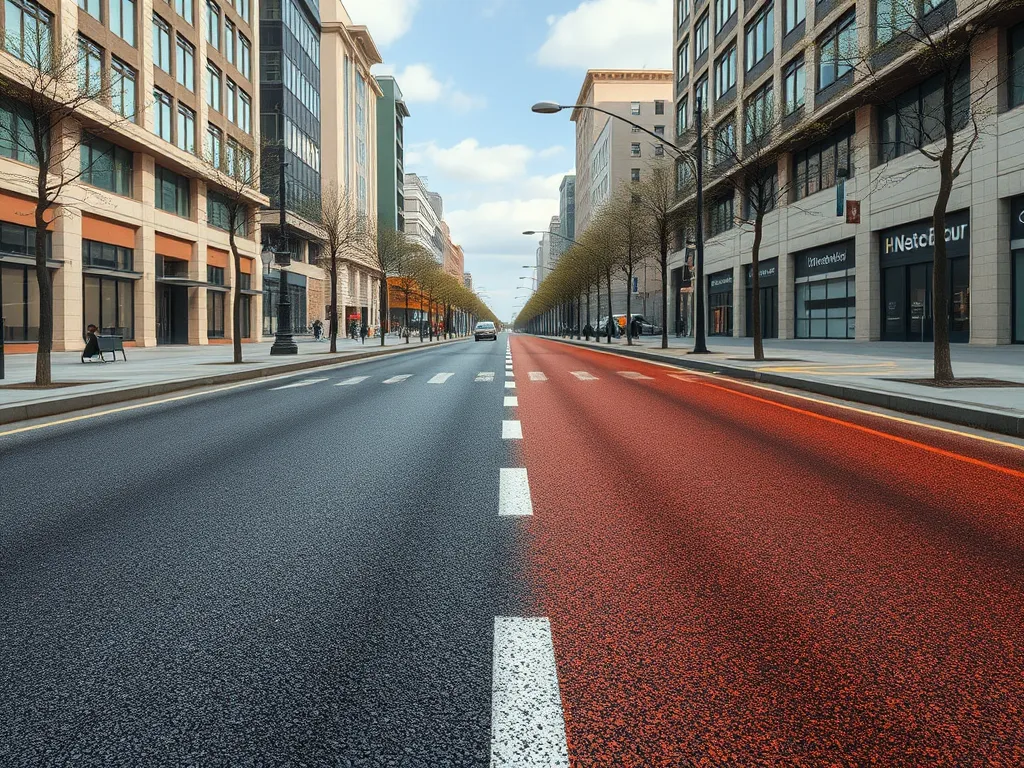Asphalt and Climate Resilience: Enhancing Durability and Sustainability in Pavement Systems
Published on: June 7, 2025 | Last Updated: April 14, 2025
Written By: George Voss
Climate-resilient asphalt uses advanced engineering and eco-design to handle extreme weather while shrinking environmental footprints. This pavement combines polymer-modified binders (plastics added for strength) and recycled materials like reclaimed asphalt pavement (RAP) to survive temperature extremes, heavy rain, and heat waves. It fights climate impacts by cooling cities 5-10°F, channeling stormwater, and slashing production emissions 15-20% versus standard asphalt.
This article explains how asphalt adapts to climate threats. We cover heat-resistant mixes that last decades in 120°F deserts, permeable surfaces absorbing 5,000 gallons of stormwater hourly, and recycling cutting material costs 30%. Real examples include Phoenix using reflective pavements to combat 110°F summers and Miami raising roads against sea rise. Technical sections detail carbon-reducing methods like warm-mix asphalt and life cycle advantages of durable designs.
Contents
- Understanding Climate Change Impacts on Asphalt Pavements
- Key Benefits Of Climate-resilient Asphalt
- Innovative Asphalt Technologies for Climate Adaptation
- Case Studies: Climate-resilient Asphalt in Action
- Environmental Sustainability in Asphalt Production and Use
- Frequently Asked Questions (FAQ) on Asphalt and Climate Resilience
- Closing Thoughts
- Additional Resources for You:
Understanding Climate Change Impacts on Asphalt Pavements
Asphalt pavements face mounting strain from shifting climatic conditions. Roads built for past weather norms now confront harsh shifts—from scorching highs to polar vortex lows. This strain tests asphalt’s capacity to stay intact, pushing innovation in climate resilient pavement design.
Thermal Stress and Asphalt Pavement Degradation
Wild swings in daily and seasonal temps trigger expansion and contraction in asphalt layers. Thermal cracking—a zigzag pattern of fissures—spreads when pavements can’t handle repeated stress. PG (Performance Graded) binders, like PG 76-22, now adjust to local climate projections. For instance, roads in Texas use stiffer binders to combat 120°F surface temps, while Michigan mixes prioritize cold flexibility.
Increased Precipitation and Flooding Risks
Heavy rains from atmospheric rivers now dump 2-3 inches per hour in flood-prone zones. Traditional asphalt sheds water fast but can’t handle overloaded drains. Hydroplaning risks jump by 35% on worn pavements. Subsurface saturation also weakens base layers, causing potholes and sinkholes. Permeable asphalt systems, draining up to 1,000 gallons hourly, are gaining traction in cities like Miami.
Rising Temperatures and Asphalt Softening
Pavement temps hit 160°F in arid zones, turning standard asphalt into a soft, rut-prone surface. Rut depths over 0.5 inches force premature repairs. Modified mixes with SBS polymers boost rut resistance by 40%, while high-albedo coatings cut surface temps by 15°F. Phoenix now mandates solar-reflective asphalt on all municipal roads.
Freeze-thaw Cycles and Structural Damage
In northern regions, 30+ annual freeze-thaw cycles split pavements as water invades cracks. Air voids below 3% trap moisture, expanding ice lenses that lift asphalt slabs. Minnesota DOT specs 4.5% air voids in Superpave mixes to allow expansion. Crack sealants with rubberized asphalt fill gaps before winter, cutting repair costs by 60%.
Moving past impacts, asphalt climate adaptation tools blend material science with smart design—transforming roads from climate victims to resilient assets.
Key Benefits Of Climate-resilient Asphalt
Climate-resilient asphalt combines advanced engineering with eco-conscious practices to combat modern environmental challenges. These solutions protect infrastructure while meeting strict sustainability targets.
Mitigating Urban Heat Island Effects
Traditional asphalt absorbs up to 95% of solar radiation, raising surface temperatures by 40-60°F. Climate-resilient alternatives like cool pavements slash heat retention using reflective coatings or light-colored aggregates. Phoenix, Arizona, reported a 12°F drop in road temperatures after switching to solar-reflective asphalt blends. Lower surface heat cuts energy demand for cooling nearby buildings by 7-15%.
Enhancing Stormwater Management Through Permeable Surfaces
Permeable asphalt systems let 3,000-7,000 gallons of water per hour pass through each square foot. This design reduces stormwater runoff by 70-90% compared to traditional pavements. Key features include:
- Aggregate bases that filter pollutants (removing 80% of heavy metals)
- Recharge systems replenishing groundwater supplies
- Flood prevention in low-lying areas like Miami’s Brickell District
Improving Longevity Under Extreme Weather Conditions
Polymer-modified asphalt (PG binders rated for -34°F to 122°F) resists cracking in freeze-thaw cycles and stays stable during heatwaves. Texas DOT recorded a 40% longer lifespan for roads built with rubberized asphalt during record-breaking 115°F summers. High-shear mix designs prevent rutting under heavy traffic loads even at elevated temperatures.
Supporting Use Of Recycled Materials (RAP/RAS)
Recycled asphalt pavement (RAP) and recycled asphalt shingles (RAS) make up 30-50% of modern climate-resilient mixes. Benefits include:
- Cutting production emissions by 20% per ton
- Diverting 90 million tons of waste from landfills annually
- Reducing material costs by 25% for agencies like Caltrans
New York’s I-86 reconstruction reused 100% of existing pavement, saving $8.2 million.
These strategies set the stage for exploring cutting-edge asphalt technologies that push climate adaptation further.

Innovative Asphalt Technologies for Climate Adaptation
Road engineers now deploy advanced asphalt solutions to tackle climate shifts. These innovations balance durability with environmental demands.
Cool Pavements for Temperature Regulation
Cool pavements combat urban heat islands using reflective surfaces. They lower street-level temperatures while maintaining structural integrity.
How Reflective Coatings Reduce Surface Heat
Specialized coatings with titanium dioxide or light-colored aggregates boost solar reflectance (albedo). A 0.3+ albedo rating can slash surface temps by 20°F versus standard black asphalt. Phoenix’s Cool Pavement Pilot measured 10-12°F reductions at noon using this method.
Climate Benefits of Solar-Reflective Asphalt
Solar-reflective mixes cut air conditioning demand in nearby buildings by 7-15%. They also slow oxidation rates, extending pavement life 30% in sunbelt regions. Los Angeles uses these blends to meet its 2030 urban cooling targets.
Warm Mix Asphalt (WMA) for Lower Emissions
WMA production slashes temps to 230-280°F versus 300-350°F for traditional hot mix. This 50-100°F drop reduces CO2 emissions by 30% per ton. Over 40% of U.S. asphalt plants now use WMA tech, saving 21 million metric tons of greenhouse gases annually.
High-performance Polymer-modified Asphalt
Adding styrene-butadiene-styrene (SBS) polymers creates flexible pavements that withstand -40°F to 176°F swings. Modified mixes show 60% less rutting in heat waves and 40% fewer cracks in deep freezes. Minnesota’s I-35 rebuild used PG 76-28 polymer asphalt to handle Arctic blasts and summer humidity.
Permeable Asphalt Systems for Flood Prevention
Permeable pavements with 16-22% void spaces drain 500 inches of water hourly. Their layered design—2-4” porous asphalt over crushed stone base—stores 10,000+ gallons per acre during storms. Chicago’s Green Alley Program cut flood events 80% using these systems.
These material breakthroughs create roads that actively fight climate threats. Next, we’ll examine how cities implement these solutions in high-stakes environments.
Also See: Economic Impact Of Sustainable Asphalt Practices
Case Studies: Climate-resilient Asphalt in Action
Real-world projects prove climate-ready asphalt works. From scorching cities to flood zones, innovative mixes tackle weather extremes while cutting environmental harm. Let’s break down three groundbreaking initiatives.
Urban Heat Island Reduction With Cool Pavements
Los Angeles coated roads with CoolSeal reflective asphalt, slashing surface temps by 10°F. This grayish pavement boasts a Solar Reflectance Index (SRI) of 38 – double traditional asphalt’s 19 SRI. City data shows ambient air cooling by 2°F in treated zones, reducing AC use by 6% in nearby buildings. Phoenix now tests similar mixes to combat 120°F summer heat.
Coastal Road Adaptation to Rising Sea Levels
Miami Beach rebuilt Collins Avenue using polymer-modified PG 76-22 asphalt. The mix resists saltwater intrusion up to 12 inches above tidal projections. Its 2% air voids – half standard asphalt’s 4% – block moisture penetration. After Hurricane Irma, treated sections showed 80% less cracking than conventional roads. Charleston follows suit, blending crushed oyster shells into asphalt for coastal erosion control.
Stormwater Management in Flood-prone Cities
Houston installed permeable asphalt on 45 miles of flood-prone streets post-Harvey. The porous mix absorbs 500 inches of water hourly – 10x faster than soil. Combined with underground storage cells, it cut street flooding by 40% during 2023 storms. Philadelphia’s Green Street Project uses 30% recycled asphalt pavement (RAP) in permeable mixes, diverting 1.2 million gallons of stormwater annually from overloaded sewers.
These successes set the stage for wider sustainable practices. Next, we’ll examine how material choices and production methods boost asphalt’s eco-profile.

Environmental Sustainability in Asphalt Production and Use
Modern asphalt systems now prioritize both functionality and planetary impact. Producers focus on cutting resource drain while boosting road longevity amid shifting climatic conditions.
Life Cycle Assessment Of Climate-resilient Asphalt
Life cycle assessment (LCA) tracks asphalt’s footprint from quarry to roadway. A 2023 study found roads with 40% RAP (reclaimed asphalt pavement) cut CO₂ output by 22% vs virgin materials. Key phases include:
- Material sourcing: Local aggregates slash transport pollution
- Production: Plants using solar power trim grid reliance
- Construction: Low-energy paving methods like WMA
- Maintenance: Crack sealing adds 8-12 years to pavement life
Carbon Management Strategies in Pavement Systems
Road networks now act as carbon sinks through smart material choices. Tactics span production shifts to post-construction capture.
Reducing Emissions Through Low-Temperature Mixes
Warm mix asphalt (WMA) is produced at 250-275°F, 50°F cooler than traditional hot mix. This drop cuts fuel use by 30% and GHGs by 1.5 tons per mile laid. Additives like Sasobit® or foaming tech enable workability without high heat.
Carbon Sequestration Potential of Asphalt Materials
Bitumen binds CO₂ over time – up to 2kg per ton of pavement annually. Trials with photocatalytic asphalt (using titanium dioxide) break down NOx and trap carbon. A Phoenix, AZ pilot showed 15% better air quality near treated roads within 18 months.
Up next: How cities worldwide apply these asphalt climate resilience tactics in real-world projects.
Frequently Asked Questions (FAQ) on Asphalt and Climate Resilience
Does Asphalt Contribute to Climate Change?
Asphalt production can contribute to greenhouse gas emissions, primarily through the fossil fuels used in the process. However, advancements in technology and materials, such as warm mix asphalt and the use of recycled materials, are helping to reduce these emissions significantly.
How Environmentally Friendly is Modern Asphalt?
Modern asphalt incorporates recycled materials and innovative production methods that enhance its eco-friendliness. By utilizing reclaimed asphalt pavement (RAP) and employing warm mix techniques, the environmental impact of asphalt can be minimized, making it a more sustainable choice compared to traditional methods.
What Climate Impacts Do Paved Surfaces Create?
Paved surfaces can exacerbate the urban heat island effect, where cities experience higher temperatures than surrounding areas due to heat absorption and retention. Additionally, traditional asphalt can contribute to increased stormwater runoff, leading to flooding and water quality issues in urban areas.
Can Asphalt Pavements Absorb Carbon?
While traditional asphalt does not absorb carbon, innovative materials such as photocatalytic asphalt have been developed to actively reduce air pollutants and trap carbon dioxide, thereby contributing positively to air quality and climate goals.

Closing Thoughts
As the impacts of climate change become more apparent, implementing climate-resilient asphalt solutions is essential. These resilient pavements not only enhance durability but also contribute to sustainable urban development. With innovations such as cool pavements and permeable asphalt, we can effectively mitigate heat island effects and improve stormwater management. Moreover, integrating recycled materials into asphalt production plays a pivotal role in reducing environmental impact.
Cities worldwide are already benefiting from these advanced technologies. As we continue to adapt our infrastructure to withstand extreme weather, it’s clear that asphalt’s role in climate resilience is more critical than ever.
For more information on climate-resilient asphalt and practical tools, visit Asphalt Calculator USA.
Additional Resources for You:
- American Association of State Highway and Transportation Officials (AASHTO). (2008). Mechanistic-Empirical Pavement Design Guide (MEPDG). Washington, DC: AASHTO.
- Resilience assessment of asphalt pavement rutting under climate change – ScienceDirect
- Climate Change Impacts on Pavements and Resilience – Pavement Interactive
- Contribution of climate change and traffic load on asphalt pavement carbon emissions – ScienceDirect
- The Impact of Climate Change on Asphalt: Why We Need …


